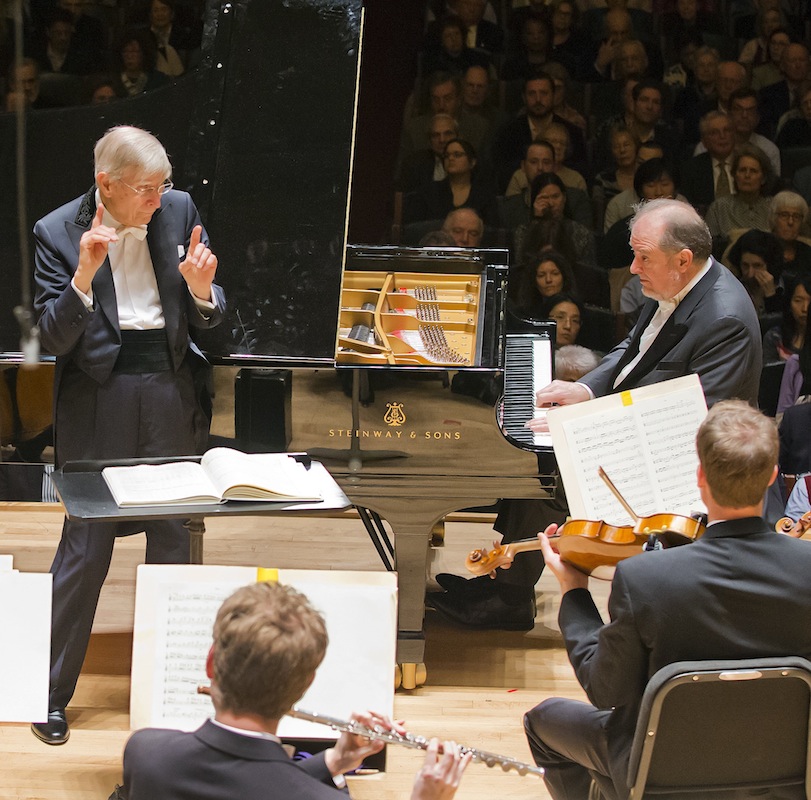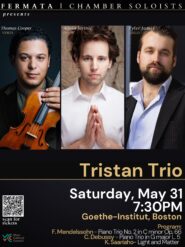Blomstedt, 88, brings youthful verve to Beethoven with BSO

Herbert Blomstedt conducts Beethoven’s Piano Concerto No. 1 with soloist Garrick Ohlsson Thursday night. Photo: Winslow Townson
The Boston Symphony Orchestra’s performance of two seminal Beethoven works at Symphony Hall Thursday night proved an unavoidable truth: the classics never seem to get old.
Beethoven’s music still makes up the backbone of any seasonal program. Yet there’s always a concern that such regularity will result in the music coming off as stale.
Thursday’s program consisting of the First Piano Concerto and Seventh Symphony, led by Herbert Blomstedt, was revelatory, the music seeming to shine anew.
The 88-year-old Swedish maestro has a sterling reputation for his interpretations of German repertoire. In the past, his Beethoven was marked by stately tempos, and the music’s energy came from clean, precision cut rhythms and a firm sense of dramatic weight.
Yet Blomstedt’s reading of the symphony Thursday night blazed with dance-like energy, an effect achieved through quick tempos. The main theme of the first movement was a true Vivace while the finale was frenzied, with rhythms sounding with whipcrack precision. The laughing Scherzo was able to do so in its lively pace, and even the trios, which are normally taken at slower tempos, had an intensity that churned just below the surface.
Blomstedt conducts without a baton, choosing instead to lead with a mix of waving and sweeping gestures. His right hand, kept open, guides the action, and the conductor wielded it like a sword, swinging it quickly to punctuate the loud chords of the outer movements.
The gem of this performance was the second movement, which Blomstedt shaped with subtle weight to each alternating pulse. Countermelodies, as they entered, took on a vocal arch, and the conductor carefully wove the fugal section from strands of melody to build the music into a satisfying climax.
The opener, Beethoven’s Piano Concerto No. 1 in C major, fared just as well.
This piece was actually the second concerto the composer wrote. Completed in the mid 1790s, the work already shows signs of the composer’s mature, weighty pianistic style as it presses against the edges of Viennese classicism.
The soloist, pianist Garrick Ohlsson, is a regular favorite in the BSO’s performances of Beethoven and Brahms piano concertos. His most recent appearance was at Tanglewood last summer, when he offered a pristine rendition of the Emperor Concerto.
His performance of the Apollonian First Concerto was remarkable for its tonal color and delicacy. Ohlsson played the work as one would early Beethoven, rendering the themes with a Mozartean touch while giving a nod to the melodic and harmonic twists and turns that characterize Beethoven’s style.
Blomstedt led the orchestra in an opening that had a Viennese grace, and Ohlsson answered with passages of crystalline tone. His technique is considerable, and the pianist deftly handled the runs and triple trills that peppered the cadenza.
In the second movement, Ohlsson’s tone took on a full, almost fruity sound as the pianist handled the phrases with gentle vibrato. To accompany, Blomstedt wove a silky bed of orchestral sound, the texture highlighted by solo clarinet as it spun silky melodies around the pianist.
The Rondo finale took off at a romping pace, the music having equal parts courtly grace and the verve of a village band. Ohlsson spun flowing melodies from the many trills that seemed to twist in place, like a kite in the wind.
Gracious applause brought Ohlsson back to the stage multiple times, yet there was no encore forthcoming.
The program will repeat 1:30 p.m. Friday and 8 p.m. Saturday and Tuesday at Symphony Hall. bso.org; 617-266-1200
Posted in Performances
